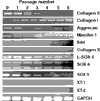Tissue engineering: chondrocytes and cartilage
- PMID: 12110124
- PMCID: PMC3240137
- DOI: 10.1186/ar561
Tissue engineering: chondrocytes and cartilage
Abstract
Tissue engineering offers new strategies for developing treatments for the repair and regeneration of damaged and diseased tissues. These treatments, using living cells, will exploit new developments in understanding the principles in cell biology that control and direct cell function. Arthritic diseases that affect so many people and have a major impact on the quality of life provide an important target for tissue engineering. Initial approaches are in cartilage repair; in our own programme we are elucidating the signals required by chondrocytes to promote new matrix assembly. These principles will extend to other tissues of the musculoskeletal system, including the repair of bone, ligament and tendon.
Figures



References
-
- UK Centre for Tissue Engineering in the Universities of Manchester and Liverpool. http://www.ukcte.org
-
- National Institutes of Health (USA) website. http://www.nih.gov/news/stemcell/primer.htm
-
- Venn G, Billingham MEJ, Hardingham TE. The increased proteoglycan synthesis in cartilage in experimental canine osteoarthritis does not reflect a permanent change in chondrocyte phenotype. Arthritis Rheum. 1995;38:525–531. - PubMed
-
- Hazell PK, Dent C, Fairclough JA, Bayliss MT, Hardingham TE. Changes in glycosaminoglycan epitope levels in knee joint fluid following injury. Arthritis Rheum. 1995;38:953–959. - PubMed
-
- Hardingham TE. In: In Oxford Textbook of Rheumatology. Maddison PJ, Isenberg DA, Woo P, Glass DN, editor. Oxford, New York, Tokyo: Oxford Medical Publications; 1998. Articular cartilage. pp. 405–420.
Publication types
MeSH terms
LinkOut - more resources
Full Text Sources
Other Literature Sources
Medical

